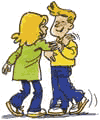What is R time?
R time is an exciting, dynamic, fun-filled Personal and Social Education programme. The emphasis is upon creating effective, respectful relationships by way of Random Pair work. R time has been shown to improve behaviour, reduce bullying, raise self-esteem and accelerate learning.
It requires no special materials and is simple to deliver.
All of the 30 activities per year group are written in a structured format and are to be simple to deliver.
R time is a programme that enables children to learn the skills of making and sustaining friends and friendships. Children learn and develop courtesy and respect to a broad range of peers and cultivate the language that makes relationships work well. Self-esteem is raised, bullying is reduced and children have a greater sense of well- being. All this is an aid to good learning.
The programme is for all Early Years Foundation Stage and Primary aged children of all abilities. It is a whole-school, every pupil programme - all children will benefit and so will the adults working with them.
The essence of the R time approach is a weekly lesson that lasts between 10 - 15 minutes and contains 6 component parts. Below is the step - by - step structure of R time with clips of video:
The video clips are taken from an R time Training DVD which is included in with the first Manual ordered by the school - it can be purchased separately - click here to go to Order Form
Step 1. R time Rule and Instruction (Expectations)
During R time there are always expectations that children will use good manners, make eye contact when speaking, use each other's names and use the respectful language of taking turns, sharing and fairness.
Step 2. Random Pairing
 The children love working each time with a different partner enabling them, over time, to work with all of the children in the class. Just watch the relationships improve!!
The children love working each time with a different partner enabling them, over time, to work with all of the children in the class. Just watch the relationships improve!!
"Random pairing is the single element of R time that the children enjoy about R time."
"I love working with new people."
"I learn about people in my class who I never would even have spoken to."
"I have got to like some children who I was afraid of."
"Thanks to R time I've now got friends I don't even like."
Step 3. Introduction (Greeting)
 Once the children are in pairs, either on the classroom carpet (where they sit face to face) or sitting at a desk ( where they incline their chairs towards each other), they greet each other by name, taking turns.
Once the children are in pairs, either on the classroom carpet (where they sit face to face) or sitting at a desk ( where they incline their chairs towards each other), they greet each other by name, taking turns.
This can be a simple greeting or extended by sharing some information with the partner.
Step 4. The Activity
 The 30 activities for each year group are for the teacher to lead and present. None are educationally challenging but all rely on process rather than content.
The 30 activities for each year group are for the teacher to lead and present. None are educationally challenging but all rely on process rather than content.
The process, through which the teacher is guided, emphasises throughout the activity, the interpersonal skills of relationships and respectful communication.
Step 5. Plenary or Feedback
 The children, led by the teacher, have the opportunity to reflect on the activity they have shared with their partner and how their cooperative interaction enabled it to be a success......or otherwise!
The children, led by the teacher, have the opportunity to reflect on the activity they have shared with their partner and how their cooperative interaction enabled it to be a success......or otherwise!
Step 6. Conclusion
 At the end of the session the children thank their partner. This can be a simple "thank you" using partners name or, perhaps a sentence beginning with “thank you for...." which will reflect how they have worked together.
At the end of the session the children thank their partner. This can be a simple "thank you" using partners name or, perhaps a sentence beginning with “thank you for...." which will reflect how they have worked together.
Each R time session ends on this positive note.

